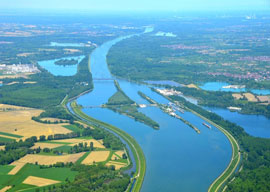
February 12, 2014

The River Rhine
Source: Shutterstock
Mountain crest boundaries can make a lot of sense for lowland civilizations, but the people who live in the mountains generally don’t agree. The classic example is the Durand Line of 1893 establishing the border between Afghanistan and British India (now Pakistan) more or less along the watershed divide, with the Khyber Pass as the chief portal. While this made sense on paper, the mountains bisected by the Durand Line are home to the enormous Pashtun population, who continued to wander back and forth between the countries.
Mountaineers”whether Pashtuns, Chechens, Scottish Highlanders, or West Virginians“tend to be fractious, ornery, and brave. Winston Churchill, who fought the Pashtuns (or Pathans) in 1897 just east of the Durand Line, noted, “Every family cultivates its vendetta; every clan, its feud….The life of the Pathan is thus full of interest….” Not surprisingly, the Pashtuns have contributed the great majority of the Taliban guerillas whom the United States has been fighting in Afghanistan for most of this century.
Fortunately, some hill tribes, most famously the Swiss, have managed to work out a modus vivendi with their neighbors in which they stop raiding the lowlanders and the lowlanders stop invading them.
Another reason mountain borders turn out to be more complicated than they might seem can be understood by thinking about a stylized version of the tactical situation. If your border is drawn along the highest ridgeline, then any penetration by the enemy can be threatening because now he’s fighting downhill. So it’s tempting to push your defensive fortifications over the top and down the other side so your rival has to march uphill to get to them. But your forward defense posture probably just irritates your neighbor, so now you’d better push even lower down in the hills on their side. And once you reach the level land beyond the mountains, well, the hard part is over, so maybe it would be most prudent to just go ahead and conquer your lowland opponents before they conquer you.
You can see a bit of that in Russia’s history in the Caucasus. This formidable mountain range, where Prometheus was chained to a rock, was the original continental divide between Asia to the south and Europe to the north.
In the 19th century, the Czarist Empire extended its holdings beyond the crest of the Caucasus. Sochi and its ski resorts are actually in the first valley south of the main crest of the Caucasus as it peters out at the Black Sea, putting these Winter Olympics arguably in Asia.
In 1864, after 101 years of war, the Russians finally conquered the last redoubt of the Circassian Muslims deep in the Caucasus Mountains at what’s now the Olympic Krasnaya Polyana ski village. Russia accepted the Circassians who pledged loyalty to the Czar and shipped the other half-million off to the Ottoman Empire.
South of the Caucasus, the Russian and Soviet Empires incorporated Georgia, Armenia, and Azerbaijan, then granting these Soviet republics independence with the collapse of the Soviet Union in 1991. Yet post-communist Russia decided to hang on to the friendly territories south of the mountains in Georgia, South Ossetia, and the Harry Potterish-sounding Abkhazia (which begins just a few miles south of Sochi).
During the 2008 Summer Olympics, the government of Georgia, having buttered up America and Israel, invaded Russian-held South Ossetia, much to the surprise of Putin, who was spectating in Beijing.
But the stylized logic of a mountain border tripped up the bumptious Georgians. The Russians still held enough of the south side of the Caucasus to make reconquering South Ossetia fairly easy. The Georgian military tried to climb to the south exit to the Roki Tunnel under the Caucasus in time to prevent the startled Russian Army from pouring tanks through. But they failed and were beaten badly by reinforcements from Russia.
For security purposes during the Olympics, Russia has temporarily pushed its de jure border seven miles further south into what Moscow considers the Republic of Abkhazia, much to the annoyance of the North Atlantic Treaty Organization, whose vague gesture in April 2008 toward making Georgia a member of this military alliance helped trigger that small country’s bizarre attack on its giant neighbor.
Georgia’s coastline on the Black Sea”like Ukraine’s”connects to the North Atlantic via the Bosporus, Dardanelles, Mediterranean, and Straits of Gibraltar. Whether or not this makes Georgia and Ukraine promising members of NATO is a geography debate over which Russia and America continue to disagree.